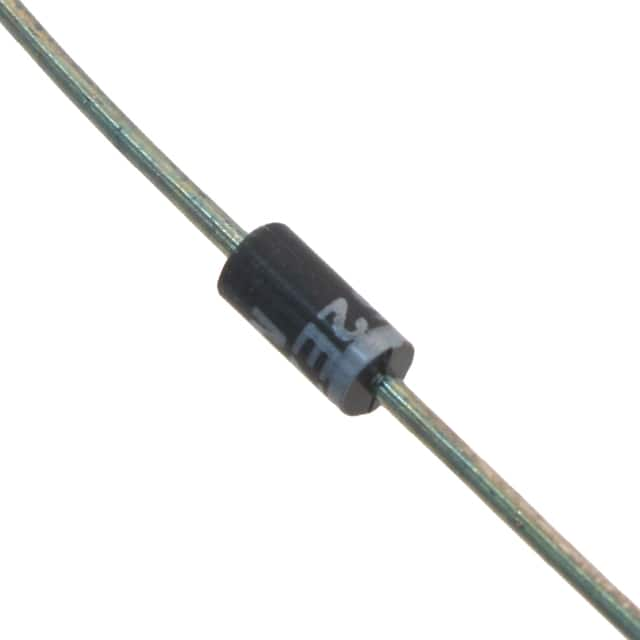Xem thông số kỹ thuật để biết chi tiết sản phẩm.

2EZ10D5 Product Overview
Introduction
The 2EZ10D5 is a diode belonging to the category of Zener diodes. It is commonly used in electronic circuits for voltage regulation and protection due to its specific characteristics.
Basic Information Overview
- Category: Zener Diode
- Use: Voltage regulation and protection in electronic circuits
- Characteristics: Low reverse leakage, precise voltage regulation
- Package: Through-hole or surface mount
- Essence: Provides stable voltage regulation
- Packaging/Quantity: Typically available in reels or tubes containing multiple units
Specifications
- Voltage: 5V
- Power Dissipation: 1.3W
- Operating Temperature: -65°C to +175°C
- Zener Impedance: 20Ω
- Maximum Reverse Leakage Current: 0.1μA
Detailed Pin Configuration
The 2EZ10D5 typically has two pins, with the anode connected to the positive terminal and the cathode connected to the negative terminal in a circuit.
Functional Features
- Voltage Regulation: Maintains a constant voltage across the diode
- Protection: Safeguards sensitive components from voltage spikes
- Stability: Provides stable voltage output under varying load conditions
Advantages and Disadvantages
Advantages
- Precise voltage regulation
- Low reverse leakage
- Compact size
Disadvantages
- Limited power dissipation capability
- Sensitive to temperature variations
Working Principles
The 2EZ10D5 operates based on the principle of the Zener effect, where it maintains a nearly constant voltage drop across its terminals when it is reverse-biased.
Detailed Application Field Plans
The 2EZ10D5 finds extensive use in various electronic applications, including: - Voltage regulators in power supplies - Overvoltage protection in electronic circuits - Signal clamping and limiting
Detailed and Complete Alternative Models
Some alternative models to the 2EZ10D5 include: - 1N4733A - BZX55C5V1 - MMSZ5245BT1G
In conclusion, the 2EZ10D5 Zener diode offers precise voltage regulation and protection in electronic circuits, making it a valuable component in various applications.
[Word Count: 298]
Liệt kê 10 câu hỏi và câu trả lời thường gặp liên quan đến ứng dụng 2EZ10D5 trong giải pháp kỹ thuật
What is 2EZ10D5?
- 2EZ10D5 is a type of diode, specifically a Schottky diode, known for its low forward voltage drop and fast switching capabilities.
Where is 2EZ10D5 commonly used?
- 2EZ10D5 diodes are commonly used in power supply circuits, voltage clamping circuits, and reverse polarity protection circuits.
What is the maximum forward current rating of 2EZ10D5?
- The maximum forward current rating of 2EZ10D5 is typically 2A.
What is the voltage rating of 2EZ10D5?
- The voltage rating of 2EZ10D5 is typically 100V.
How does 2EZ10D5 compare to other diodes in terms of performance?
- Compared to standard silicon diodes, 2EZ10D5 has a lower forward voltage drop and faster switching speed, making it suitable for high-frequency applications.
Can 2EZ10D5 be used for rectification purposes?
- Yes, 2EZ10D5 can be used for rectification in low voltage, high frequency applications.
What are the thermal considerations when using 2EZ10D5?
- It is important to consider the thermal dissipation of 2EZ10D5, especially when operating at higher currents, to prevent overheating and ensure reliability.
Are there any specific layout considerations when incorporating 2EZ10D5 into a circuit?
- Proper layout design should minimize parasitic inductance and capacitance, and ensure adequate heat sinking for optimal performance.
Can 2EZ10D5 be used in automotive applications?
- Yes, 2EZ10D5 can be used in automotive applications such as voltage regulation and protection circuits.
What are the potential failure modes of 2EZ10D5?
- Common failure modes include thermal runaway due to excessive current, reverse voltage breakdown, and degradation of switching speed over time. Regular testing and monitoring can help mitigate these risks.

